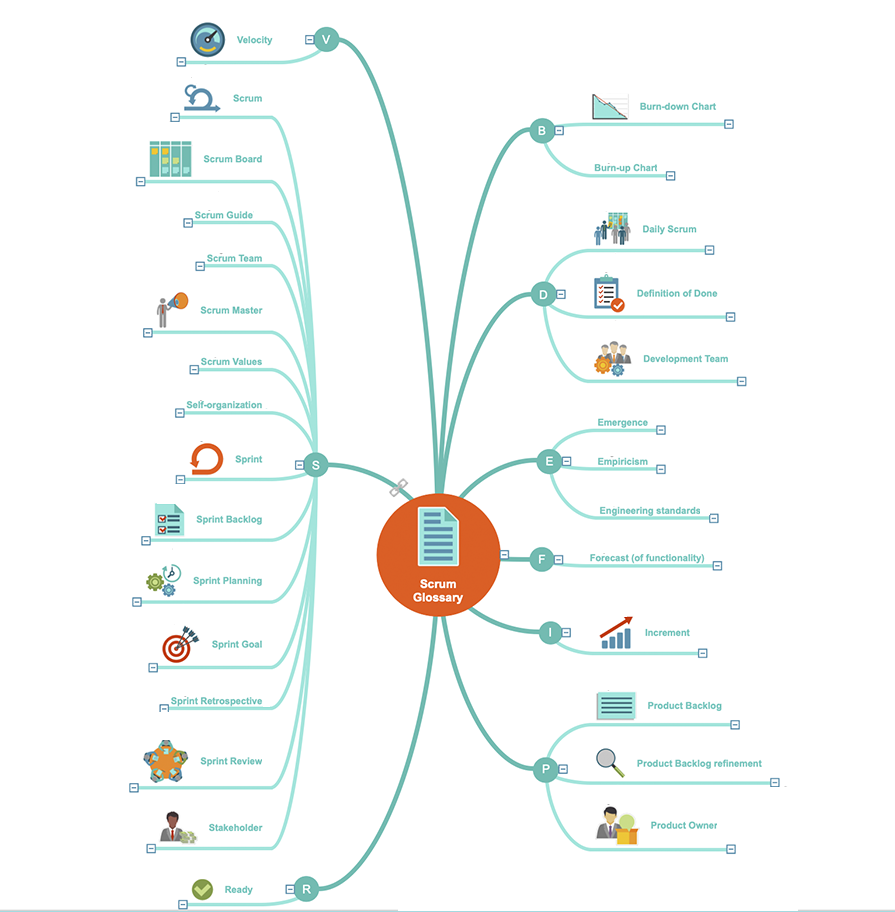Agile Scrum Terminologies
The most popular scrum terminologies in Agile methodology are specified below -

- Burndown Chart - A Burndown Chart is a graphical representation of work left to do versus time. It helps teams monitor their progress during a Sprint, ensuring they're on track to meet their goals.
- Burnup Chart - A Burnup Chart shows the amount of work that has been completed versus the total work planned. It’s useful for tracking progress and understanding if the team is ahead or behind schedule, especially when scope changes.
- Daily Scrum - The Daily Scrum is a 15-minute time-boxed event held each day for the Development Team. It allows team members to synchronize their work and plan for the next 24 hours.
- Definition of Done - The Definition of Done is a shared understanding of what it means for work to be complete. It ensures transparency and quality by defining the criteria that must be met for a Product Backlog item to be considered "Done."
- Development Team - The Development Team consists of professionals who do the work of delivering a potentially releasable Increment of "Done" product at the end of each Sprint. They are self-organizing and cross-functional.
- Epic - An Epic is a large body of work that can be broken down into smaller User Stories. It represents a big feature or goal that takes more than one Sprint to complete.
- Increment - An Increment is the sum of all the Product Backlog items completed during a Sprint and the value of the increments of all previous Sprints. It must be in usable condition regardless of whether the Product Owner decides to release it.
- Product Backlog - The Product Backlog is an ordered list of everything that is known to be needed in the product. It is managed by the Product Owner and evolves as the product and the environment in which it will be used evolve.
- Product Owner - The Product Owner is responsible for maximizing the value of the product resulting from the work of the Development Team. They manage the Product Backlog and ensure that it is visible, transparent, and clear to all.
- Refinement (Backlog Grooming) - Backlog Refinement is the process of reviewing and updating Product Backlog items before the next Sprint. It ensures the backlog is clean, clear, and ready for Sprint Planning.
- Scrum - Scrum is an Agile framework that helps teams work together to develop, deliver, and sustain complex products. It emphasizes collaboration, accountability, and iterative progress toward a well-defined goal.
- Scrum Board - A Scrum Board is a visual tool used to manage tasks during a Sprint (like a digital to-do board). It helps the team see what work is in progress, what’s completed, and what’s left to do.
- Scrum Master - Role within a scrum team who is accountable for coaching, guiding, teaching, and assisting a scrum team.
- Scrum Team - Scrum Team is a self-Organizing team which consists of a Product Owner, Scrum Master and Development team.
- Sprint - A Sprint is a time-boxed period, usually one to four weeks, during which a Scrum Team works to complete a set amount of work. Each Sprint aims to produce a potentially shippable product increment.
- Sprint Backlog - The Sprint Backlog is the set of Product Backlog items selected for the Sprint, plus a plan for delivering the product Increment and realizing the Sprint Goal. It is created during Sprint Planning and is updated throughout the Sprint.
- Sprint Goal - The Sprint Goal is a short description of what the team aims to achieve during the Sprint. It gives the team a shared focus and direction throughout the Sprint.
- Sprint Planning - Sprint Planning is a time-boxed event that initiates the Sprint. The entire Scrum Team collaborates to define the Sprint Goal and select Product Backlog items to include in the Sprint.
- Sprint Retrospective - The Sprint Retrospective is an opportunity for the Scrum Team to inspect itself and create a plan for improvements to be enacted during the next Sprint. It occurs after the Sprint Review and prior to the next Sprint Planning.
- Sprint Review - The Sprint Review is held at the end of the Sprint to inspect the Increment and adapt the Product Backlog if needed. During the Sprint Review, the Scrum Team and stakeholders collaborate about what was done in the Sprint.
- Stakeholder - A person who is not part of the Scrum team but has a specific interest in and knowledge of the product is represented by the product owner. This individual is engaged actively with the Scrum team during the sprint review to facilitate incremental discovery.
- Story Points - Story Points are a way to estimate the size or complexity of a task. They don’t represent time but show how difficult a piece of work is compared to others.
- Task - A Task is the smallest unit of work in Scrum, usually created from breaking down User Stories. Tasks are specific and actionable items the team works on during the Sprint.
- User Story - A User Story is a simple description of a feature written from the perspective of the end user. It usually follows this format: "As a [user], I want [feature] so that [benefit]."
- Velocity - Velocity is the number of story points (or work items) a team completes in a Sprint. It helps the team estimate how much work they can realistically commit to in future Sprints.
